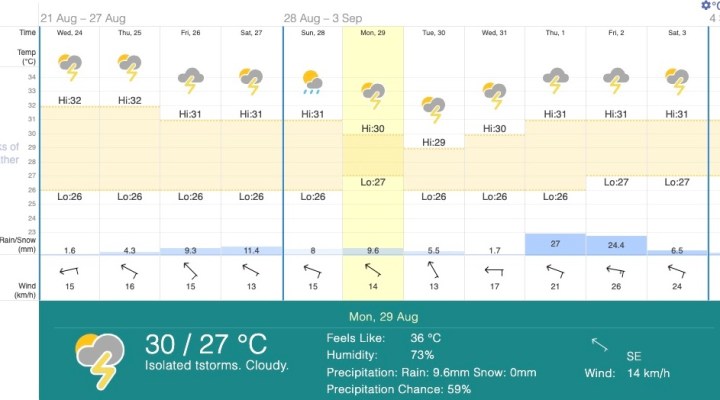NASA is making final preparations for the maiden flight of its next-generation Space Launch System (SLS) rocket and Orion spaceship for the Artemis I mission to the moon.
NASA’s most powerful rocket to date is set to lift off from the Kennedy Space Center in Florida on Monday, August 29, in what promises to be one of the most spectacular Space Coast launches in decades.
But it can only get away on time if the weather plays ball.
The launch window opens at 8:33 a.m. ET on Monday, and remains open for two hours. But the current weather forecast (below) for the launch site suggests stormy weather could force NASA to postpone the lift-off.

NASA has shared a detailed list of launch criteria that have to be met in order for the SLS to launch safely.
For starters, the rocket cannot be filled up with fuel if the 24-hour average temperature at both 132.5 feet and 257.5 feet is less than 41.4 degrees Fahrenheit.
Once fueled, the SLS will only be able to launch if the temperature at both 132.5 feet and 257.5 feet is lower than 94.5 degrees Fahrenheit for 30 consecutive minutes.
But the launch also depends on wind conditions. So, for example, lift-off winds must be below a range of 29 knots through 39 knots between 132.5 feet and 457.5 feet, respectively, with limits also placed on upper-level wind conditions.
NASA also has to assess the chances of lightning strikes and cannot, for example, launch for at least 30 minutes if lightning is observed within 10 nautical miles of the flight path.
Clouds in the area will also be carefully monitored, with certain formations and types likely to delay the launch.
Finally, if there’s any precipitation at or near the Kennedy Space Center around launch time, NASA will halt the countdown.
In all, NASA outlines 17 “do not launch” criteria for the Artemis I mission, and so if we couple that with Florida’s reputation for stormy summer weather, don’t be too surprised if the SLS rocket and Orion spaceship don’t get away on schedule.
The space agency won’t make a final decision until it’s had a chance to evaluate the forecast from the 45th Weather Squadron, which provides detailed weather assessments for air and space operations in the U.S. That forecast is expected any time now.
If the SLS rocket and Orion spaceship fail to get away on Monday, the next launch opportunity will be on September 2, and after that on September 5.
We’ll be sure to share any information regarding any timetable changes just as soon as we know. For now, though, Monday’s launch is still on, and you can watch a livestream of the entire event.


